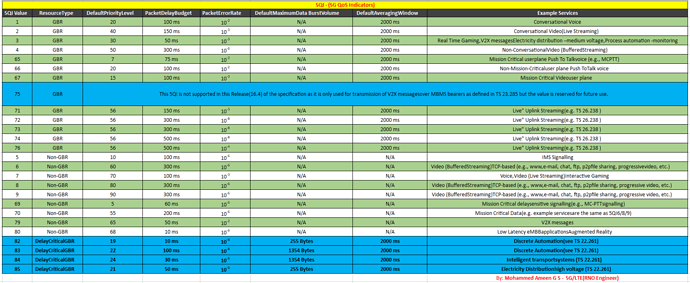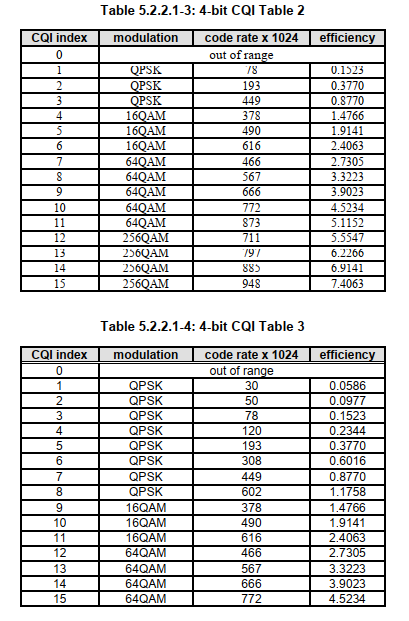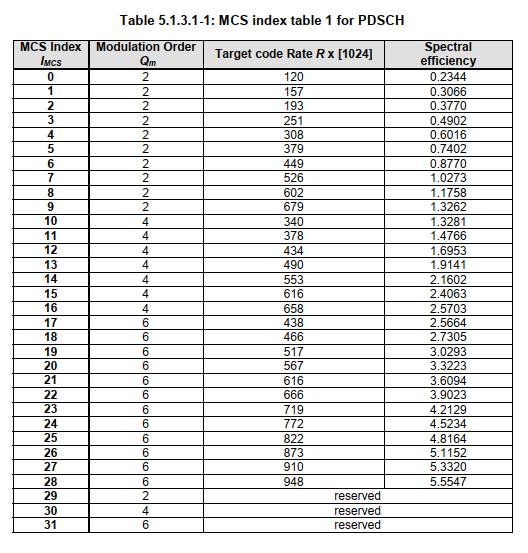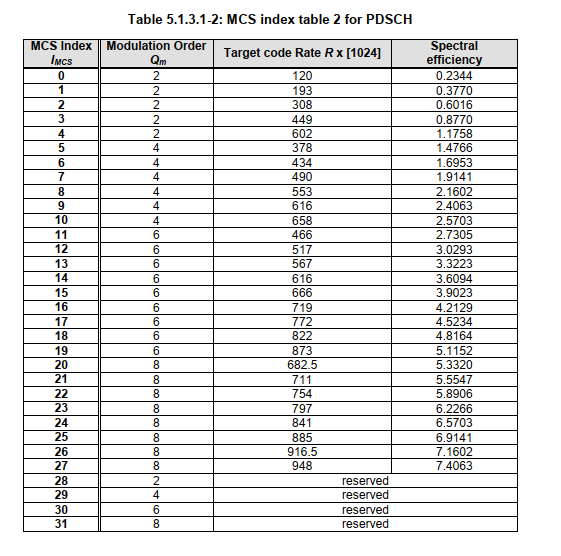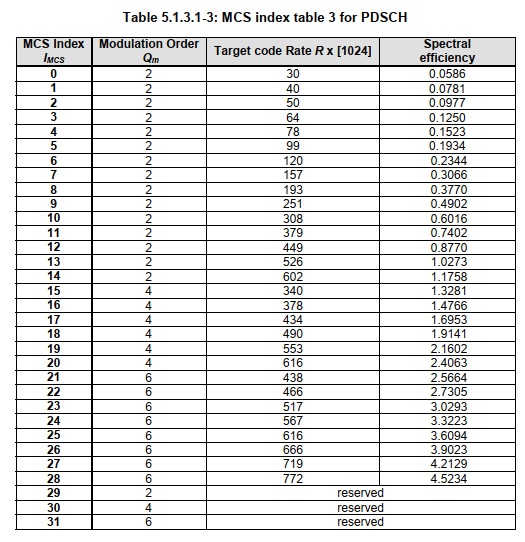I want 5G QCI, 5G CQI, MCS value and what is ARP in 5G.
Brother,
Below are the 5QI,CQI and MCS values for your reference.
First of all, We have Multiple 5Q(QCI) with advance QoS implementation . Now its called as 5QI in 5G .
Below table For your reference.
CQI
We have totally 3 CQI tables, which CQI table values will be allocated to UE purely based on the radio conditions and UE should consider more things in 5G.
Can be understood by the below details as per 3GPP
A combination of modulation scheme and transport block size corresponds to a CQI index if:
- the combination could be signaled for transmission on the PDSCH in the CSI reference resource according to the
Transport Block Size determination described in Subclause 5.1.3.2, and - the modulation scheme is indicated by the CQI index, and
- the combination of transport block size and modulation scheme when applied to the reference resource results in the effective channel code rate which is the closest possible to the code rate indicated by the CQI index. If morethan one combination of transport block size and modulation scheme results in an effective channel code rate equally close to the code rate indicated by the CQI index, only the combination with the smallest of suchtransport block sizes is relevant
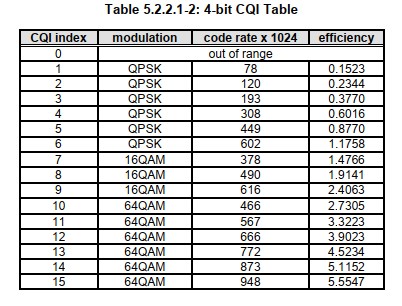
Similarly we have 3 tables for MCS
For the PDSCH scheduled by a PDCCH with DCI format 1_0 or format 1_1 with CRC scrambled by C-RNTI, MCS-CRNTI, TC-RNTI, CS-RNTI, SI-RNTI, RA-RNTI, or P-RNTI, or for the PDSCH scheduled without corresponding PDCCH transmissions using the higher-layer-provided PDSCH configuration SPS-config,
if the higher layer
parameter mcs-Table given by PDSCH-Config is set to ‘qam256’, and the PDSCH is scheduled by a PDCCH with DCI format 1_1 with CRC scrambled by C-RNTI
- the UE shall use IMCS and Table 5.1.3.1-2 to determine the modulation order (Qm) and Target code rate R used in the physical downlink shared channel.
elseif
the UE is not configured with MCS-C-RNTI, the higher layer parameter mcs-Table given by PDSCH-Config is set to ‘qam64LowSE’, and the PDSCH is scheduled by a PDCCH in a UE-specific search space with CRC scrambled by
C-RNTI - the UE shall use IMCS and Table 5.1.3.1-3 to determine the modulation order (Qm) and Target code rate R used in the physical downlink shared channel.
elseif
the UE is configured with MCS-C-RNTI, and the PDSCH is scheduled by a PDCCH with CRC scrambled by
MCS-C-RNTI - the UE shall use IMCS and Table 5.1.3.1-3 to determine the modulation order (Qm) and Target code rate R used in the physical downlink shared channel.
elseif
the UE is not configured with the higher layer parameter mcs-Table given by SPS-config, the higher layer parameter mcs-Table given by PDSCH-Config is set to ‘qam256’, - if the PDSCH is scheduled by a PDCCH with DCI format 1_1 with CRC scrambled by CS-RNTI or
- if the PDSCH is scheduled without corresponding PDCCH transmission using SPS-config,
- the UE shall use IMCS and Table 5.1.3.1-2 to determine the modulation order (Qm) and Target code rate R
used in the physical downlink shared channel.
elseif
the UE is configured with the higher layer parameter mcs-Table given by SPS-config set to ‘qam64LowSE’ - if the PDSCH is scheduled by a PDCCH with CRC scrambled by CS-RNTI or
- if the PDSCH is scheduled without corresponding PDCCH transmission using SPS-config,
- the UE shall use IMCS and Table 5.1.3.1-3 to determine the modulation order (Qm) and Target code rate R used in the physical downlink shared channel.
else - the UE shall use IMCS and Table 5.1.3.1-1 to determine the modulation order (Qm) and Target code rate R used in the physical downlink shared channel
end
The UE is not expected to decode a PDSCH scheduled with P-RNTI, RA-RNTI, SI-RNTI and Qm > 2
Thank u hi ameen one more what is ARP and any table is there for 5G
Dear,
ARP Allocation and Retention Priority is just used for controlling call admission. Indicates a priority value used to decide whether to activate a new SDF(Service Data Flow) or EPS(Evolved Packet System) bearer by removing an existing one in a network with limited resources.
Once an SDF or EPS bearer is established, ARP has no impact on the packet forwarding treatment.
ARP has the following parameters:-
Priority level (1 – 15):- defines relative importance of are source request, where 1 is the highest.
Preemption capability (yes or no):- defines whether an SDF or EPS bearer can get resources already assigned to another SDF or EPS bearer with a lower priority level.
Preemption vulnerability (yes or no):- defines whether an SDF or EPS bearer can lose the resources already assigned to it to an SDF or EPS bearer with a higher priority level.
You can check this in EndcProfile configuration for QCI 1 5 and 9 specially.
EndcProfile controls how the S1-U shall be terminated for EN-DC capable UEs (meNbS1TermReqArpLev) and if configuration of split bearers is allowed for the UE (splitNotAllowedUeArpLev).
Below Example for your understanding .
QCI 9 - SN Split bearer:
ARP.PriorityLevel is higher than (>) meNbS1TermReqArpLev, this bearer will be setup as SN terminated.
ARP.PriorityLevel is higher than (>) splitNotAllowedUeArpLev, bearers in UE can be setup as SN terminated.
QCI 5 - MN MCG bearer:
ARP.PriorityLevel is lower than (<) meNbS1TermReqArpLev, this bearer will not be setup as SN terminated.
ARP.PriorityLevel is higher than (>) splitNotAllowedUeArpLev, other bearers in UE can still be setup as SN terminated.
QCI 1 - MN MCG bearer:
ARP.PriorityLevel is equal to or lower than (<=) meNbS1TermReqArpLev, this bearer will not be setup as SN terminated.
ARP.PriorityLevel is higher than (>) splitNotAllowedUeArpLev, other bearers in UE can still be setup as SN terminated.
